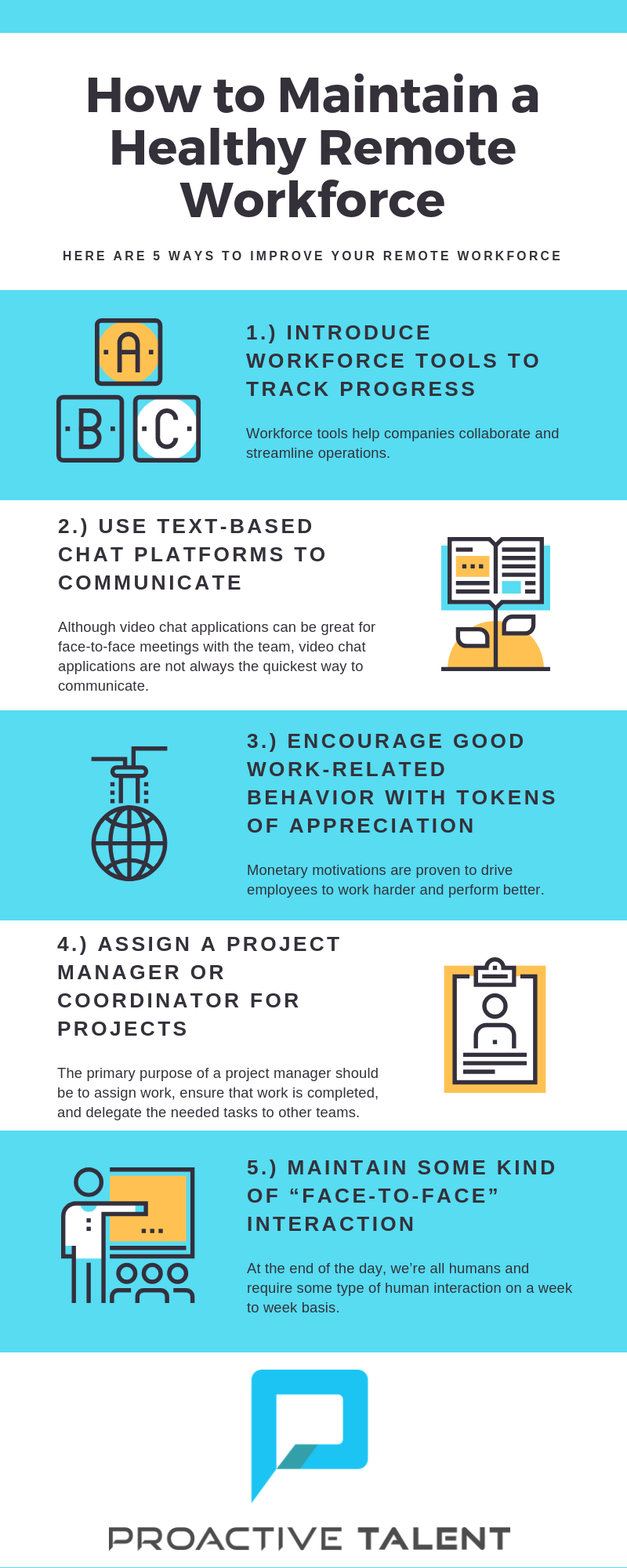.jpg)
The concept of utilizing remote workforces for low-cost operations is not a new one, yet the vast benefits of this workforce method have been recognized only recently. An increasing number of companies have started choosing this approach over working in an office environment mainly due to benefits such as flexibility and lower investments in infrastructure. However, many of the firms who have recently implemented the remote workforce culture are still struggling to understand the best ways to implement healthy habits for their remote working environments.
As the majority of our own team is remote based, we’ve found these 5 tips and tricks in supporting a remote workforce. These will help keep your remote workforce both healthy and happy.
1. Introduce Workforce Tools to Track Progress
Workforce tools help companies collaborate and streamline operations. Workforce tools to utilize can help not only track the login hours, the work to be done for the day, but also the full lifecycle of a project. Consider investing in either a readily available project management software or custom-made applications to aid in the functionality of remote workforces. Online training to help employees understand effective ways to make most out of these tools can aid the process further. Uploading training documents onto the company shared drive for future reference is an excellent way to save time and promote periodical refresher training. We use a project management software called Teamwork to track client projects, contractor hours, and give clients full visibility into our projects and daily/weekly deliverables but also to work together on internal company projects which keep all our remote employees on the same page.

2. Use Text-Based Chat Platforms to Communicate
Although video chat applications like Zoom (our personal favorite) can be great for face-to-face meetings with the team, video chat applications are not always the quickest way to communicate. Consider choosing a text-based chat platform that is easy to use and can be integrated into existing workforce tools. If the remote workforce teams have to share files as part of their daily duties, then using a software program that makes this task as painless as possible is always recommended. Our team uses Slack, which integrates well with many of our other business applications creating streamlined communication across our project teams, departments, and company as a whole. It really helps us maintain a pretty amazing remote culture acting as our own sort of digital water cooler. Not a Slack fan? There are many other chat platforms to choose from like Basecamp and Facebook Workplace. Demo a few with your team and pick the one that would get the greatest adoption.
3. Encourage Good Work-Related Behavior with Tokens of Appreciation
Most firms with offices work on an incentivized system, as monetary motivations are proven to drive employees to work harder and perform better. The same rule can be applied to remote workforce environments. For instance, friendly competitions held between teams when the star employee is recognized and rewarded. Or, announcements of the best performers in the form of weekly or bi-weekly newsletters sent out to the entire workforce to encourage the others to perform better as well. At Proactive Talent we have regular competition amongst our recruiters around performance goals and offer cash bonuses but I also like sending gifts to our employees that do amazing work or really go the extra mile using my AI gift bot tool, EvaBot.
4. Assign a Project Manager or Coordinator for Projects
The primary purpose of a project manager and coordinator should be to assign work, ensure that work is completed, and delegate the needed tasks to other teams - all of which ensure that the healthy habits for remote workforce are met as per the set criteria. Project managers and coordinators might also be responsible for handling other tasks, such as motivating teams, holding intra-company competitions and accepting feedback while passing it on to the relevant departments.
Project managers and coordinators may also be asked to ensure that all the team members are performing their daily work duties in a comfortable environment. This can be done through the form of a weekly online meet where the project managers and coordinators ask the teams about their working environments while making subtle yet helpful suggestions on ways to optimize their working environment to enhance productivity while preventing strain on the employees.
5. Maintain Some Kind of “Face-to-Face” Interaction
At the end of the day, we’re all humans and require some type of human interaction on a week to week basis. Use video conference software to conduct meetings or have monthly team meetings where everyone comes together. We like to host a company-wide retreat once or twice a year where we bring in our employees from across the country. Either way, this will ensure that each of your remote workers are staying engaged. Face-to-face interaction is key when it comes to engagement and workplace happiness. The secret to following healthy habits for remote workforces is consistency, thus we stress weekly team meets (preferably video conference) with maximum attendance.
These are a just a few strategies for enabling a remote workforce that have helped us stay connected, work efficiently, and succeed together, as a team. We hope they help you do the same!


